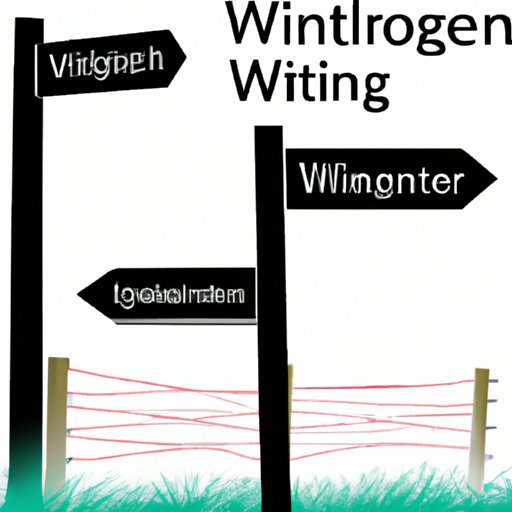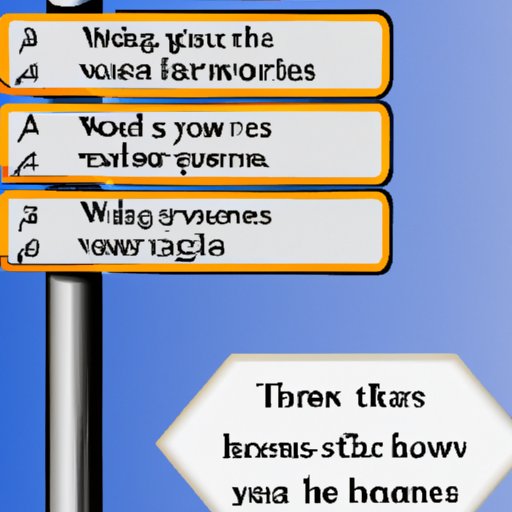Introduction
Signposting is a technique used in writing to make it more structured, organized, and easier to follow. It involves using words or phrases to direct readers and alert them to important information within the text. Signposts can be used to identify key points, break up complex topics, and highlight relevant information within a piece of writing. By incorporating signposts into your writing, you can help readers understand and engage with your text more easily.
A Guide to Incorporating Signposts into Your Writing
When it comes to including signposts in your writing, there are a few steps you should take. First, you need to identify the most important points in your text. These are the points that you want to emphasize and draw attention to, as these will be the ones to which you’ll want to add signposts. Once you’ve identified these points, you can then decide on the type of signpost to use. There are many different types of signposts, ranging from transitions to rhetorical questions to summaries, so you’ll need to think carefully about which one best suits your needs.
After you’ve selected the type of signpost to use, you need to consider how to best incorporate it into your writing. You should make sure that the signpost is clear and concise, as well as being appropriate for the context. Additionally, you should try to make sure that the signpost blends in seamlessly with the rest of the text. This way, it won’t disrupt the flow of the writing and will instead enhance it.

An Introduction to Signposting for Writers
When it comes to signposting, there are a variety of different types that you can choose from. For instance, transitions are commonly used to signal a shift in topic or to indicate a relationship between two ideas. Examples of transitions include “however,” “in contrast,” and “on the other hand.” Rhetorical questions are also popular signposts, as they can be used to draw out the reader’s thoughts and encourage them to consider a particular idea. Finally, summaries are useful for quickly summarizing a section of text or for providing an overview of the main points.
Incorporating signposts into your writing can be a tricky task. To do it successfully, you’ll need to be aware of the different types of signposts and how to use them effectively. You should also be mindful of the language you use when crafting your signposts. By using appropriate and descriptive language, you can make sure that your signposts stand out and draw the reader’s attention.

How to Use Signposts to Make Your Writing Easier to Follow
Signposts are incredibly useful for making your writing easier to follow. They can be used to organize your ideas and ensure that they flow logically from one point to the next. Additionally, signposts can be used to break up complex topics and make them easier to digest. Finally, signposts can be used to highlight key points and draw attention to the most important information in your writing.

Crafting Clear and Effective Signposts in Your Writing
Once you’ve decided to incorporate signposts into your writing, you need to make sure that they are clear and effective. To do this, you should pay close attention to the language you use when crafting your signposts. For example, avoid using vague language such as “this” or “that” and instead opt for words that are more specific and descriptive. Additionally, you should consider the tone of your signposts and make sure that it suits the overall tone of your writing.
You should also make sure that your signposts stand out. One way to do this is by using formatting, such as bold font or italics, to make the signposts more noticeable. Additionally, you can use headings and subheadings to separate signposts from the rest of the text. This will make them easier to spot and will help draw the reader’s attention to the most important points.
The Power of Signposting: Making Your Writing More Engaging
Using signposts in your writing can have a number of benefits. For instance, signposts can make your writing more engaging, as they can draw readers in and encourage them to read further. Additionally, signposts can make your writing more organized and structured, which can make it easier to follow. Finally, signposts can help you emphasize key points, which can be helpful if you’re writing an academic essay or trying to make a persuasive argument.
To make the most of signposting, you should consider how you can use them to your advantage. Think about the points you want to emphasize and the tone of your writing, and then choose signposts that fit those criteria. Additionally, you should pay attention to the language you use when crafting your signposts and make sure that they stand out from the rest of the text. By doing this, you can make sure that your signposts are both clear and effective.
Conclusion
Signposting is an important technique for any writer to master. By incorporating signposts into your writing, you can make it easier to follow, more organized, and more engaging. When it comes to signposting, it’s important to consider the type of signpost to use, the language to use when crafting it, and how to make it stand out. With the right approach, signposting can be a powerful tool for enhancing your writing.
(Note: Is this article not meeting your expectations? Do you have knowledge or insights to share? Unlock new opportunities and expand your reach by joining our authors team. Click Registration to join us and share your expertise with our readers.)
